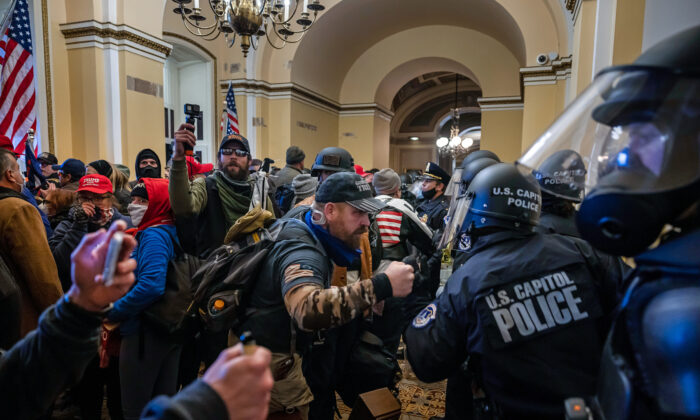U.S. Capitol Police radio traffic obtained by The Epoch Times reveals silence from the command center, which Lt. Tarik Johnson says caused delays and put lives at risk
WASHINGTON—A top U.S. Capitol Police (USCP) commander—recently retired Assistant Chief Yogananda Pittman—failed to respond to repeated urgent radio calls to evacuate the U.S. Congress on Jan. 6, 2021, causing the loss of precious time that might have prevented the shooting death of protester Ashli Babbitt, a former USCP commander said.
The delay caused by the radio silence from the Capitol Police Command Center was so urgent that the 22-year veteran lieutenant located near the U.S. Senate chamber forged ahead with the evacuation anyway. He said he feared lawmakers would be injured or killed if he didn’t lead them to safety before the chamber doors were breached by protesters.
In a series of exclusive interviews with The Epoch Times, former USCP Lt. Tarik K. Johnson, 47, detailed allegations that Pittman failed to respond to multiple urgent calls for help.
“I begged for help all day on Jan. 6, 2021, and I feel I was largely ignored,” Johnson told The Epoch Times. “I beg again on Jan. 6, 2023—exactly two years later—for the proper investigative entities to uncover what really occurred on J6, and I pray that the country hears my cry.”
Johnson said the crucial delay in the evacuations should never have happened.
“There was no response from anybody at the Command Center,” Johnson said. “I say even before I initiated evacuation, I say specifically, ‘We’ve got to start thinking about getting the people out before we don’t have a chance to.’
“I heard no response. Then I asked for permission to evacuate. I heard no response.”
Pittman, 49, who will begin a new job as chief of police at the University of California–Berkeley on Feb. 1, didn’t respond by press time to a request by The Epoch Times for comment. She announced her retirement from the USCP in November 2022.
The USCP Command Center, located on the seventh floor of the headquarters building on D Street in Washington, is a 40- by 30-foot room staffed by Capitol Police and officials from partner agencies, including the D.C. Metropolitan Police Department, the FBI, U.S. Park Police, and others.
In his new book, “Courage Under Fire,” published on Jan. 3, former USCP Chief Steven Sund, 57, said an area of the Command Center nicknamed “the pit” is used for monitoring “all the camera systems, radios, alarms, and a computer-aided dispatch terminal to monitor USCP and MPD calls for service.”
Founded by an act of Congress in 1828, the U.S. Capitol Police has more than 1,800 sworn officers, more than 500 civilian employees, and an annual budget of $602.5 million.
According to the book, Sund was in the Command Center on the afternoon of Jan. 6, 2021, but was occupied making dozens of calls to the House and Senate sergeants at arms and the Pentagon, trying to get National Guard troops sent to the Capitol. He also made and took numerous calls to arrange for mutual aid from surrounding police agencies, the book said.
There’s no indication in the book that Sund was aware of the unanswered calls for help. Johnson doesn’t fault him for the troubles. Sund did describe watching some of the Capitol violence unfold from the Command Center.
“As I sit in my Command Center watching the video screens, my frustration at the repeated delays from the sergeants at arms, along with my concern for my officers’ safety, is redlining,” Sund wrote. “To be more precise, I am [expletive] livid.”
Johnson became known to much of America as the Capitol Police lieutenant who wore a bright red Make America Great Again ball cap while he worked with a pair of Oath Keepers to rescue 16 USCP officers trapped in the foyer inside the massive Columbus Doors.
Johnson was suspended by USCP and later accused of rules violations, including conduct unbecoming, for wearing the Trump hat and working with the Oath Keepers on the officer rescue. He said he believes those charges were actually brought because the evacuations and other split-second leadership decisions he made embarrassed Pittman.
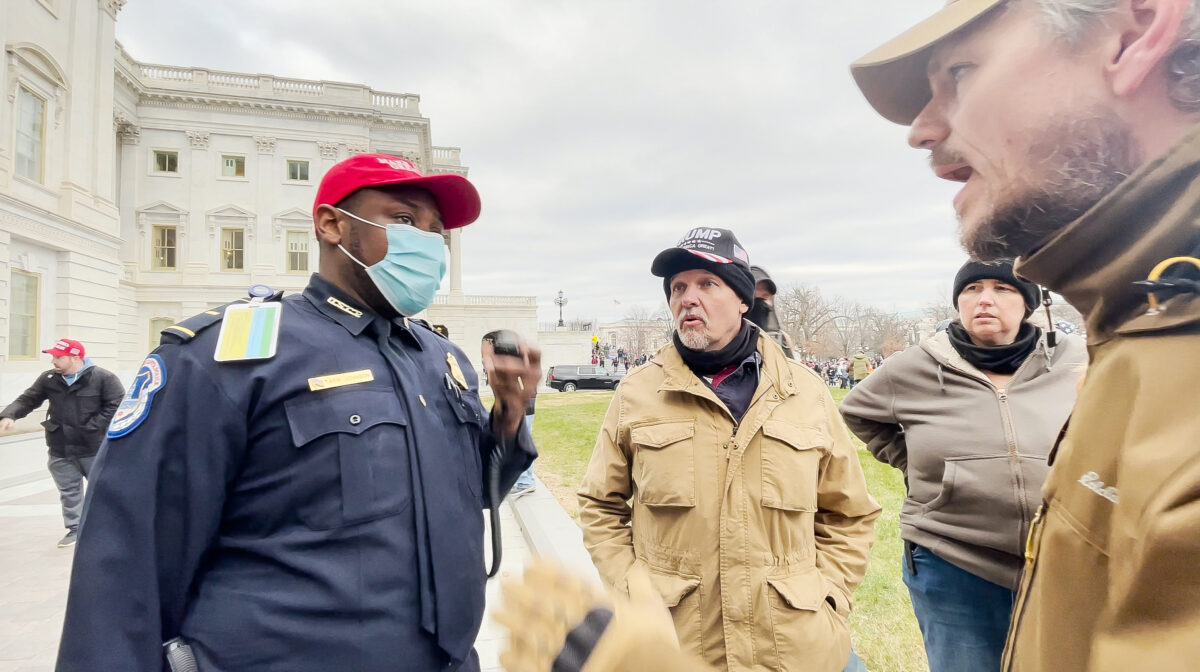
After about 17 months of suspension, Johnson got his job back but chose to resign. Johnson said wearing the MAGA cap made the crowds more receptive to him, provided a level of safety that he likened to a tactical helmet, and served as a de-escalation tool.
Johnson had been with the USCP for 22 years at the time of the Jan. 6, 2021, events, serving as a police officer, dignitary special agent, sergeant, and lieutenant. For two years prior to his USCP service, he worked for the Senate sergeant-at-arms.
One of the Oath Keepers, retired New York Police Sgt. Michael Nichols, said Johnson’s actions during the officer rescue were heroic.
“He adapted to the environment, put the officers’ and people’s safety before his own, and succeeded in defusing a tense situation that could have resulted in a mass-casualty incident,” Nichols said.
Johnson’s actions throughout the day on Jan. 6, 2021, reminded Nichols of a character in the television miniseries “Band of Brothers.”
“It’s not like he just helped these officers out, this man was like the lieutenant in ‘Band of Brothers’ who just keeps running back and forth across the battlefield to get everyone in position and on task, with no regard for self—only for what needs to be done,” Nichols told The Epoch Times. “He really saw the big picture that day.”
Rico La Starza, who documented the rescue operation on video, agreed.
“He’s the leader people pray for,” La Starza said. “Quick on the feet and willing to go through flames for his team.”
Radio Dispatch Recordings Confirm Events
Johnson’s assertions about the Senate and House evacuations were corroborated by USCP radio dispatch recordings and transcripts obtained by The Epoch Times.
The unanswered plea for authorization to evacuate was among at least four instances in which Johnson or the USCP dispatcher asked in vain for help or direction from the Command Center, where Pittman sat at the center console near Sund.
Babbitt was shot and killed by USCP Lt. Michael Byrd at 2:44 p.m. as she attempted to climb through a broken window pane leading into the Speaker’s Lobby. Shortly before that, Babbitt shouted at rioters who were vandalizing the doors and windows and chastised three Capitol Police officers for doing nothing to stop the violence.
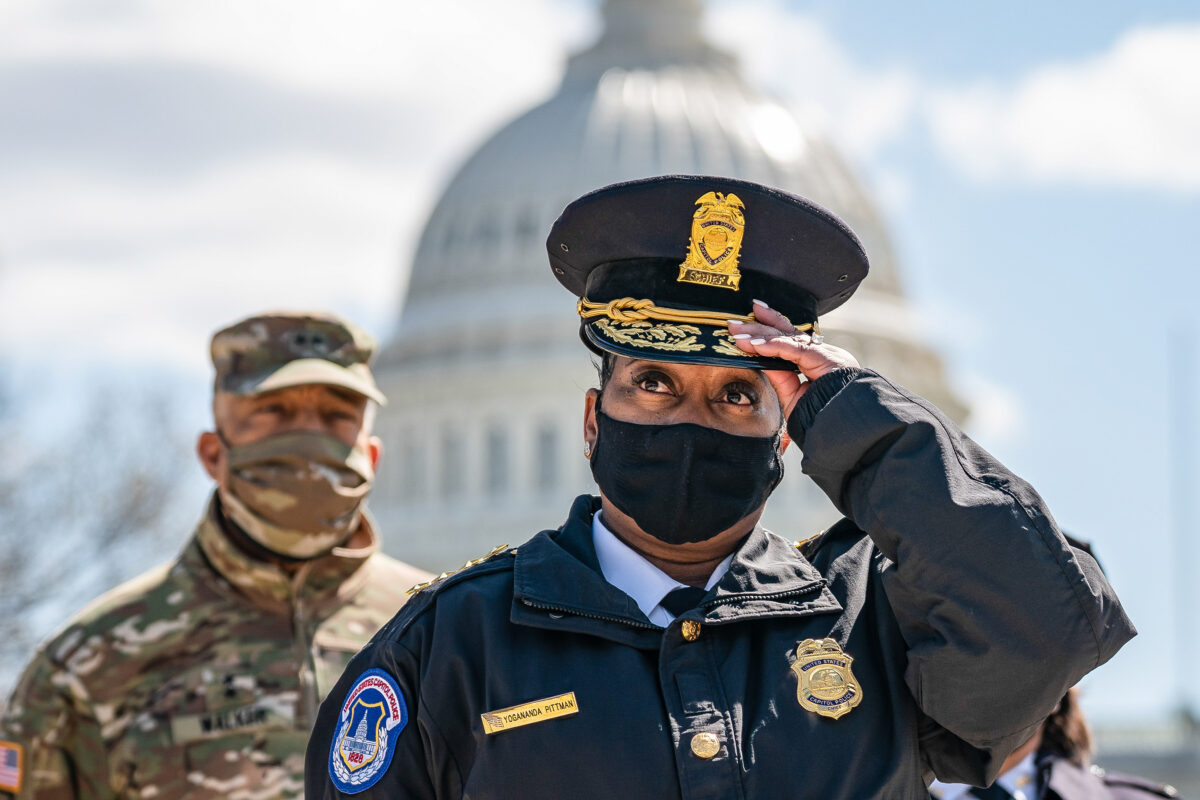
Johnson said if the evacuation of Congress started when he first asked for help, Byrd wouldn’t have been near the Speaker’s Lobby entrance, and the House chamber would have been empty if the violent crowd had somehow breached the barricaded double doors.
“I made the evacuation order at approximately 2:28 for the Senate, and then I did it maybe six to eight minutes later for the House,” Johnson said.
“[Byrd] should not have been put in that situation. Had the evacuation occurred earlier, Lt. Michael Byrd would not have been there, and Ashli Babbitt would have met a vacated lobby.”
Senate Evacuation
Audio from the main USCP radio channel provides dramatic testimony on the efforts to evacuate hundreds of lawmakers and staff.
At about 2:23 p.m., Johnson asked for authorization to have one of the Senate doors unlocked so he could get then-Senate Sergeant-at-Arms Michael Stenger into the chamber. The voice of Thomas Lloyd, USCP inspector, crackled across the radio, “Approved.”
Johnson shortly made his biggest and most urgent plea of the day.
“405J-John with a message. I want to advise that we evacuate the Senate floor before [we] won’t have a chance to,” Johnson said over the radio just after 2:25 p.m. “We have a clear directional sight to get out of the Senate door from the second floor. I need permission to go ahead and initiate that, copy.”
The dispatcher repeated Johnson’s plea.
“He has a clear sight to get everyone out,” the dispatcher said.
For a second time, the dispatcher relayed the request.
“405J-John requesting to clear the Senate floor,” he said. “He has a clear path. Clear ahead a path to get everyone out.”
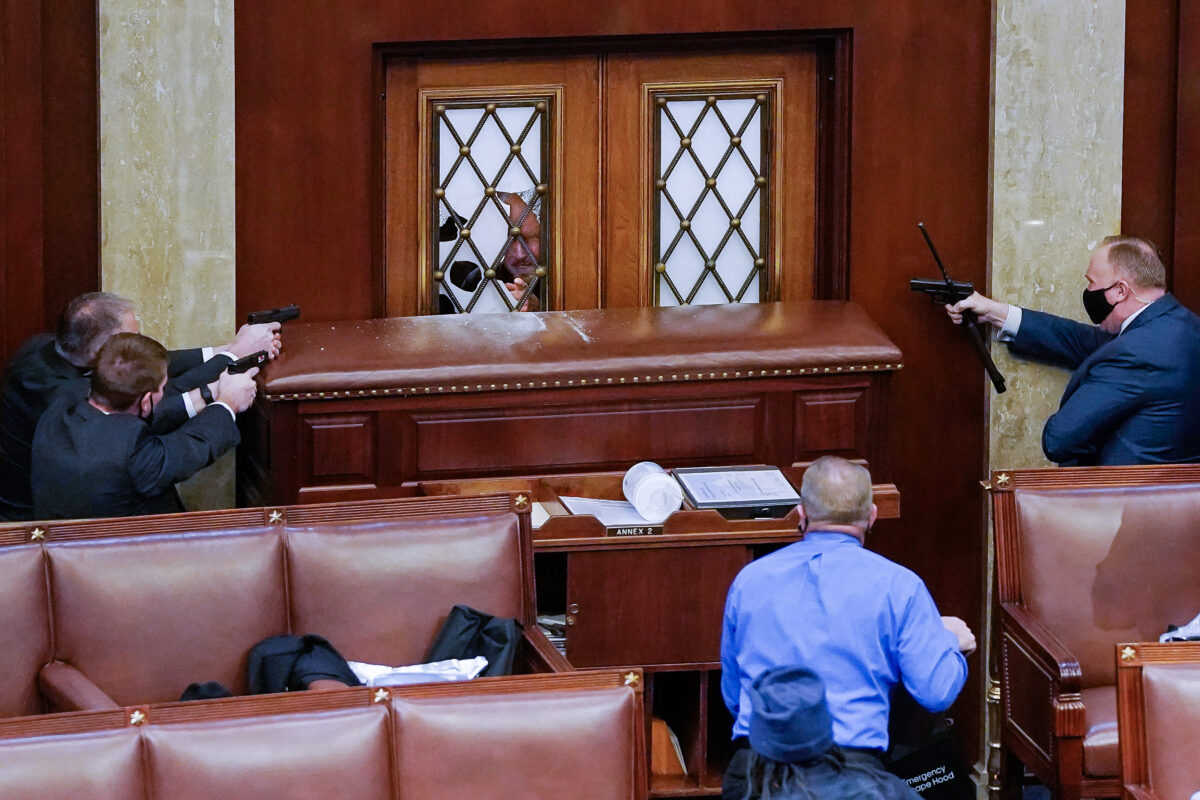
There was no reply from the command staff on the ground or in the Command Center. Johnson said Pittman, then the No. 2 official at the U.S. Capitol Police, was the person who should have made that call.
Johnson said his concern grew as the seconds and minutes ticked away.
“405J-John disregard,” he broadcasted. “I’m going to go ahead and do it anyway. I’ll take the 550 or 534. We’re evacuating now on the north side. Send everybody out the Senate door, copy.”
The numbers 550 and 534 refer to officer disciplinary codes, Johnson said.
The dispatcher responded: “I copy that. Evacuations being executed at this time, 1429 hours [2:29 p.m.].”
The official USCP Jan. 6, 2021, timeline of events states that at 2:28 p.m., “remaining members evacuated from Senate floor.”
Dispatch acknowledged the evacuation order at 2:29 p.m. At 2:32 p.m., Deputy Chief Eric Waldow broadcasted, “Senate floor is continued to be evacuated. I’m moving with the members now.”
The Senate was declared clear at 2:33 p.m.
House Evacuation
The House went into recess at 2:29 p.m. At about that time, a group of between 75 and 100 protesters—including Babbitt—began filling up the hallway outside of the Speaker’s Lobby adjacent to the House chamber. Some members of the crowd turned violent and began rioting. Agitators smashed the glass in the doors with a helmet and flag poles.
After leading the senators through the subway tunnel to safety, Johnson turned his attention to the evacuation of the House, coordinating over the radio with Sgt. Nelson Vargas, 49.
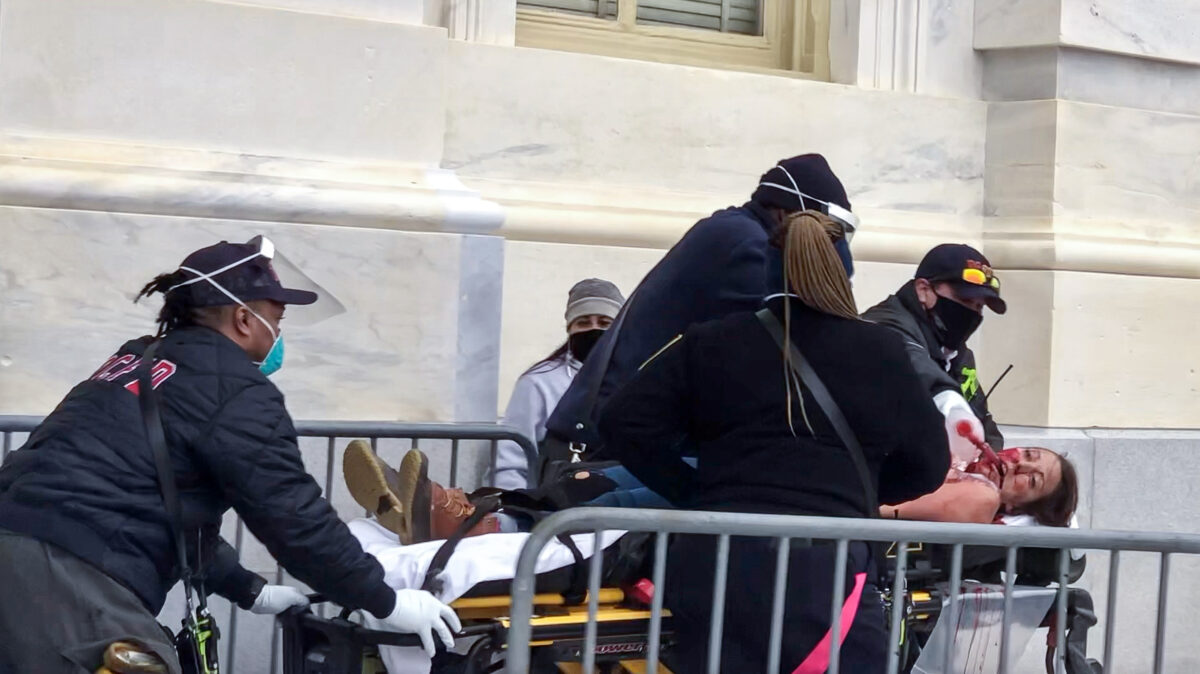
“I’ll tell you what. I’m listening. We’re trying to mobilize all units there from the main door to the other side,” Vargas said. “We’ll come into the chambers and hold the floor. Is that what you want us to do?”
Johnson responded: “You need to open the door on the House floor with the least amount of demonstrators there and take them down as far as you can go into the basement. Walk everybody over to the subway, to the House side.”
Vargas replied: “Boss, we’re on the House side right now. We’re right in front of the main door.”
Johnson said, “Use the lobby, use the lobby to go down the back steps.”
Video from the Speaker’s Lobby shows members of the House being evacuated as rioters stepped up their assault on the entrance doors and windows.
Johnson advised any police officers on the third floor of the House gallery, “It’s time to evacuate so that we can secure the members on the other side, copy.”
He was told that officers were with 12–15 members of Congress and staff in one of the House galleries.
“405J-John with a message,” Johnson broadcasted. “I need the air. I’m sending a team of officers now on the House side. What door, what gallery do they need? Are they all in one gallery, different galleries? Where are they?
“Ok, what portion of the gallery do we need assets to respond to assist officers?”
The dispatcher replied, “405J-John, I’m not getting a response at this time, sir.”
Chaos on the Air
The radio chatter depicts near chaos throughout the afternoon.
Johnson was seemingly omnipresent on the radio, moving inside and outside the Capitol, requesting a decontamination tent for pepper spray victims, securing resupplies of water, calling in paramedics to help injured officers, and directing officers with long guns to retreat into the Capitol so their weapons couldn’t be taken by rioters.
As crowds surged from the ground level up to the Lower West Terrace, Johnson ordered a pullback of forces at 1:53 p.m., concerned that the protesters might try to take the M4 rifles from officers.
“405J-John, anyone on the lower terrace now, I need you to fall back, and I need you to respond inside,” Johnson said. “If we’re not going to use lethal force, we can’t risk them taking the M4s from us, so if you have an M4, I need you to respond on the lower terrace door now.”
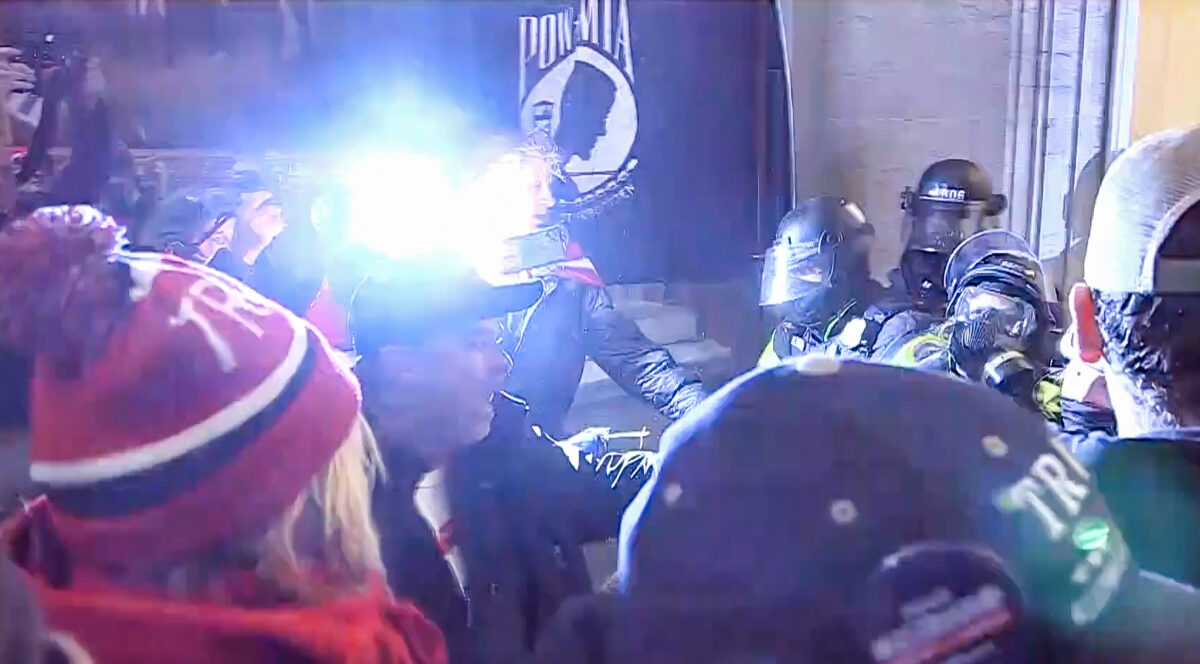
Independent journalist Steve Baker was on the terrace at the time the officers retreated into the Capitol.
“What I witnessed that day—around 2 p.m.—was a sudden pull back of all law enforcement defending that Lower West Terrace battle line,” Baker said. “Even in my own FBI interview, I told them I saw what I presumed to be a definitive ‘stand down’ order.
“I told them there was no way over 100 officers ended their confrontation with those violent agitators, then pulled back all at once without an order from someone up the chain of command. They reacted to that observation like I was full of [expletive], but I’ve since learned through my own investigations that they did, in fact, receive a pull-back order at almost exactly that moment.”
Pittman was heard sparingly on the radio that day. At 2 p.m., she broadcasted, “Unit 2, at this time, we’re ordering a lockdown of the Capitol Building. Lock down the Capitol Building.”
Lloyd, USCP commander for the Capitol Building, responded sardonically, “That was done a long time ago.”
Just before Pittman’s announcement, Johnson was on the landing outside the Lower West Terrace doors trying to organize a pull-back of police into the Capitol Building because of the surging crowds of protesters coming up from the ground level.

“405J-John, advising you that our situation here is dire,” Johnson said. “We’re about to evacuate the Lower West Terrace, and everybody’s about to go inside.”
When Pittman ordered the lockdown, Johnson asked, “405J-John, can we get in the door first before you lock it down?”
Security video from the Lower West Terrace tunnel shows dozens of U.S. Capitol Police and D.C. Metro officers withdrawing into the Capitol while the terrace was still largely clear of protesters.
The last officers backing into the tunnel fired rubber bullets at the first protesters who approached the tunnel. The projectiles didn’t deter the crowd.
The Lower West Terrace tunnel became the site of fierce fighting and violence for several hours later that afternoon. It’s not clear why the security doors were ever opened again, but eventually, dozens of officers filled the tunnel, battling with protesters trying to reach the entry doors. Gas unleashed by police in the tunnel caused a stampede that likely contributed to the death of protester Rosanne Boyland, 34, of Kennesaw, Georgia.
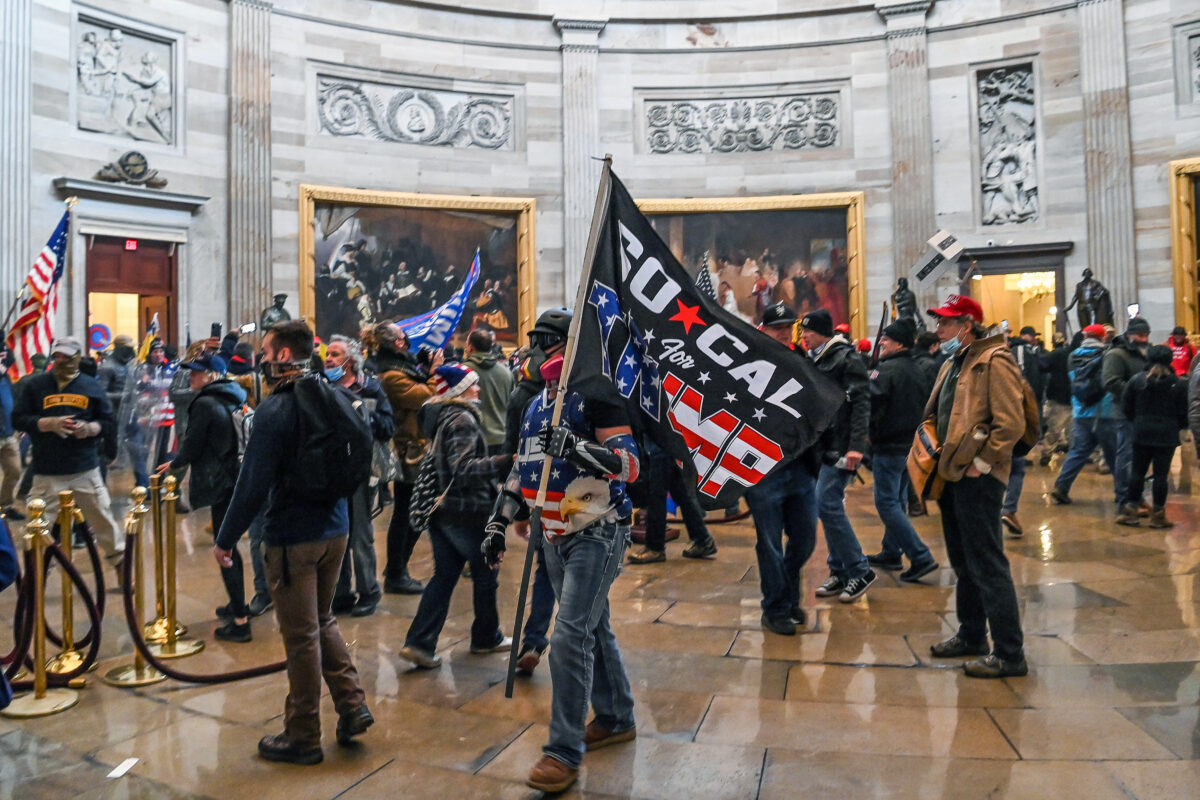
The radio traffic demonstrates how Johnson tried throughout the afternoon to get feedback, authorization, and direction—most often to no avail.
At 2:04 p.m., Johnson asked for “a CERT unit that can develop a tactical procedure where we can keep the people from breaching until we can get our people in.”
Containment and Emergency Response Teams (CERT) are the Capitol Police version of SWAT teams.
“405J-John, I’m telling you what we need. We need some kind of a tactical plan to divert these breachers so we can get everybody in the Lower West Terrace door,” he said. “We do not have any hard gear up here.
“We need a plan to get these people, these officers, back into the building. They’re coming, so we can’t stop them from breaching.”
There was no reply.
A short time later at 2:08 p.m., Pittman announced another lockdown.
“Unit 2, at this time, we are ordering a campus-wide lockdown,” Pittman said. “A campus-wide lockdown. Please simulcast.”
Johnson continued pressing for help at the Lower West Terrace entrance.
“The Lower West Terrace door, the Lower West Terrace is about to be breached, so that is the priority,” he said. “We need some kind of a CERT unit to help us to get the officers that are stuck on the Lower West Terrace door, in the Lower West Terrace door, copy.
“Ok, I’m calling for a CERT unit. I need a CERT unit. I need a plan to get those units that are at Lower West Terrace out of there.”
On the Move
A simulcast message asked for help at the Senate for a reported breach of the Capitol. Johnson moved quickly to respond.
“405J-John, I’m headed to the second floor to make sure it’s secured up there for the House chamber,” he said. “We need a lieutenant or someone to respond to the Senate chamber, the Senate chamber. I’m on the House side.”
Capt. Ben Smith ordered the House and Senate chambers locked down at 2:15 p.m. Johnson left the House side and moved toward the Senate.
Johnson again asked for input.
“We’re going to need some directions as to what we are going to do,” he said. “The Capitol is breached. We have hundreds of people in here. We need some direction. What do you guys want us to do?”
There was no reply.
‘Multi-Tiered Failure’
During a U.S. House subcommittee hearing on Feb. 25, 2021, Pittman was asked about radio communication failures that left officers without direction on fast-developing conditions.
Rep. Jaime Herrera Beutler (R-Wash.) asked Pittman to explain “the lack of communication to your officers on their radios.”
“Part of the problem there was chaos was because each one of, each and every one of these officers—boots on the ground commander or not—had to make a decision with no information,” Herrera Beutler said. “Like there was no incoming help as far as they knew. They had no idea what you guys were doing.”
Pittman blamed commanders on the ground, saying that “incident command protocols were not adhered to, as they should have.”
“Those boots on the ground view, the persons in charge of our Civil Disturbance Unit, as well as those operational commanders that are in charge of the Capitol, are responsible for implementation of that incident command system,” she said. “So when there’s a breakdown, you look for those commanders with boots on the ground to provide that instruction. That did not happen, primarily because those operational commanders at the time were so overwhelmed.”
Herrera Beutler replied, “So I want to know why yourself and the other leaders did not maintain or regain control of the comm system, because you had a bird’s-eye view advantage.”
Pittman again deferred to commanders on the ground.
“So the expectation is not that those officers would be in charge of the communication,” she said. “Those commanders would be in charge that were directly responsible that those officers reported to, because they have the tactical advantage and strategic lens, if you will.”
Herrera Beutler followed up.
“Are you saying those commanders then somehow, and this is an honest question, so the commanders failed to regain control of the comm systems and direct the officers who were on the front lines?” she asked.
Pittman replied, “I think it’s a multi-tiered failure, if you will.”
Herrera Beutler noted that the U.S. Capitol Police Labor Committee cast a 92 percent no-confidence vote on Pittman 10 days earlier.
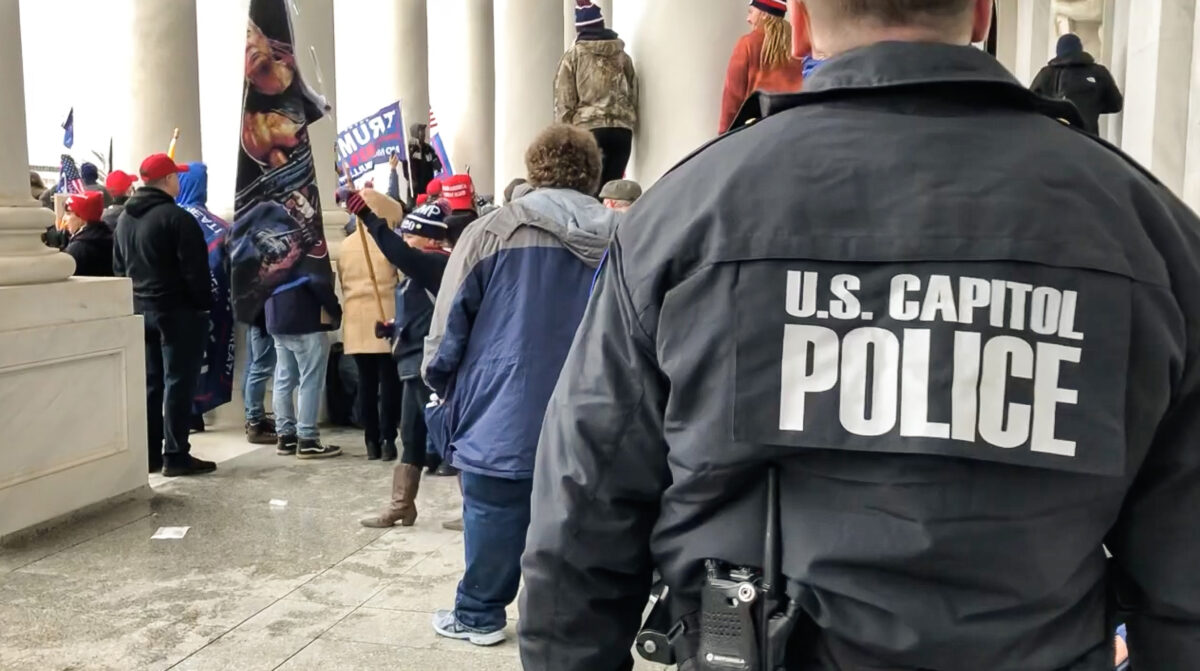
In a Jan. 27, 2021, letter (pdf), USCP Union Chairman Gus Papathanasiou said that Jan. 6, 2021, was a “leadership failure.”
“The officers are angry and I don’t blame them,” Papathanasiou said. “The entire executive team failed us and they must be held accountable. Their inaction cost lives.”
In a scathing 16-page letter (pdf) to congressional leaders in late September 2021, a former U.S. Capitol Police commander and whistleblower ripped Pittman and Deputy Chief Sean Gallagher, accusing them of “intent and malice” in their alleged failure to do their jobs on Jan. 6, 2021.
“In the Command Center, they simply watched, mostly with their hands in their laps,” the letter reads. “They did not try to help or assist as officers and officials were literally fighting for each other, their lives and the Congress.
“These two instead, while officers were being injured, elected to do nothing, lie and attempt to profit professionally. They chose to watch, as one non-USCP witness stated, ‘like two bumps on a log,’ make calls and start to blame everyone for their failures.”
As debates rage on about all that took place at the Capitol two years ago, Johnson said he decided to speak out about the failures he witnessed out of a sense of justice.
“I hope for justice for all the people that died that day and after as a result of J6,” he said. “I hope for justice for all the people that got hurt that day. I hope for justice for all the American people, as they deserve to know what really happened.”
Steve Baker contributed to this story and has actual content included here. Tuesday, January 11, 2023, Steve appeared on “TNN Live!” with Dan Newman to elaborate on these facts. You can hear that conversation here. Click on this hyperlink: Steve Baker With Dan Newman: “TNN Live!” discussing the bombshell of this story Jan.11, 2023
